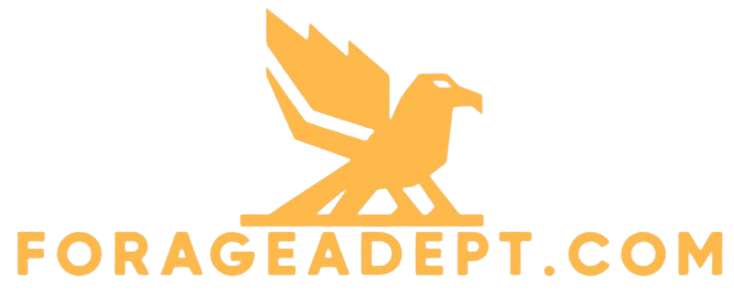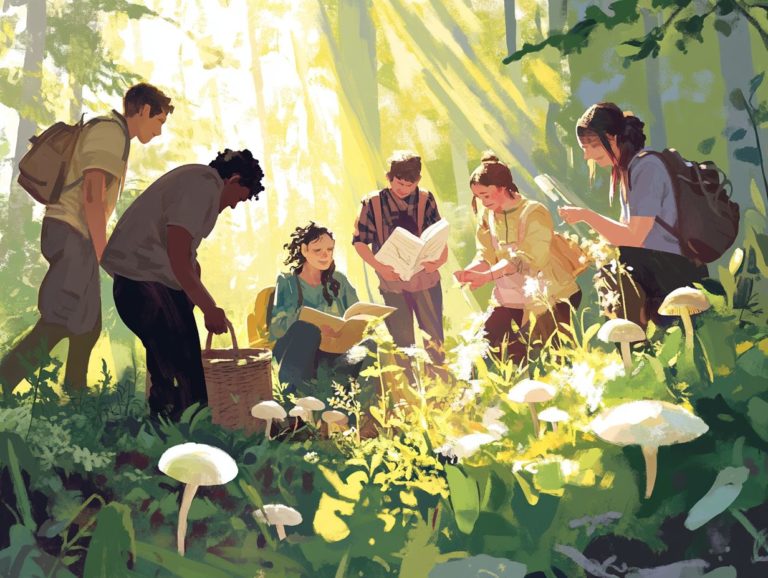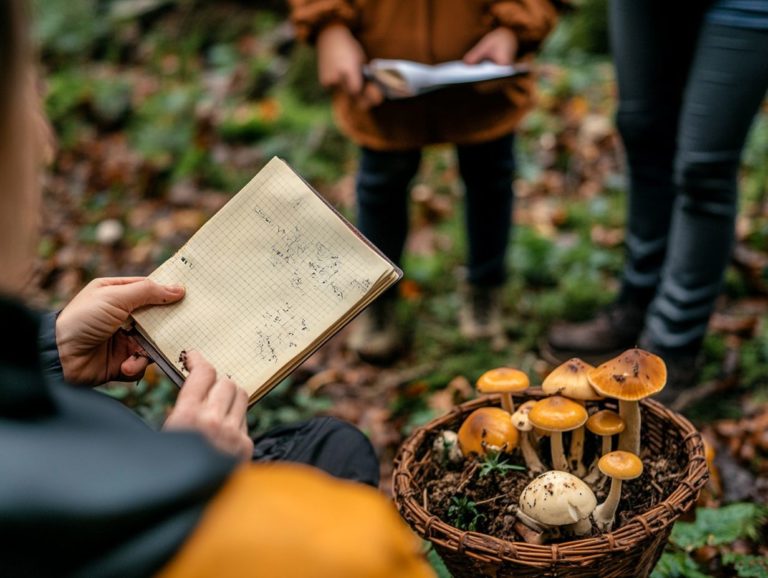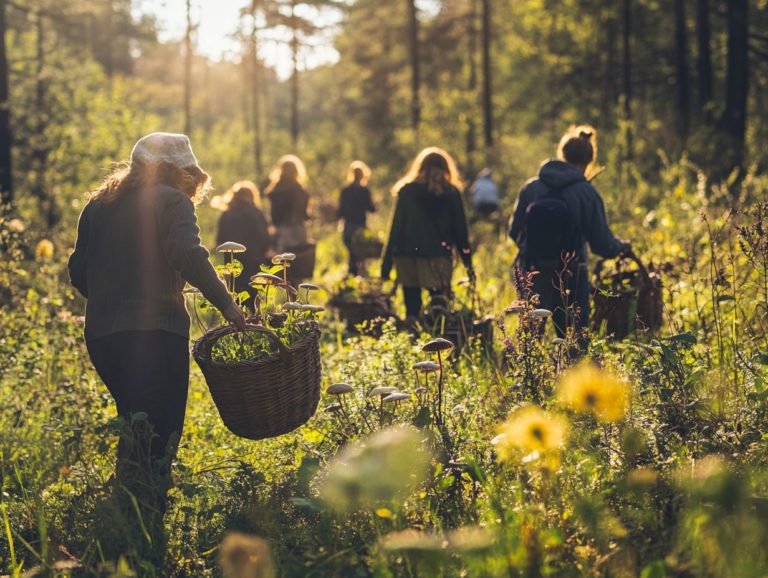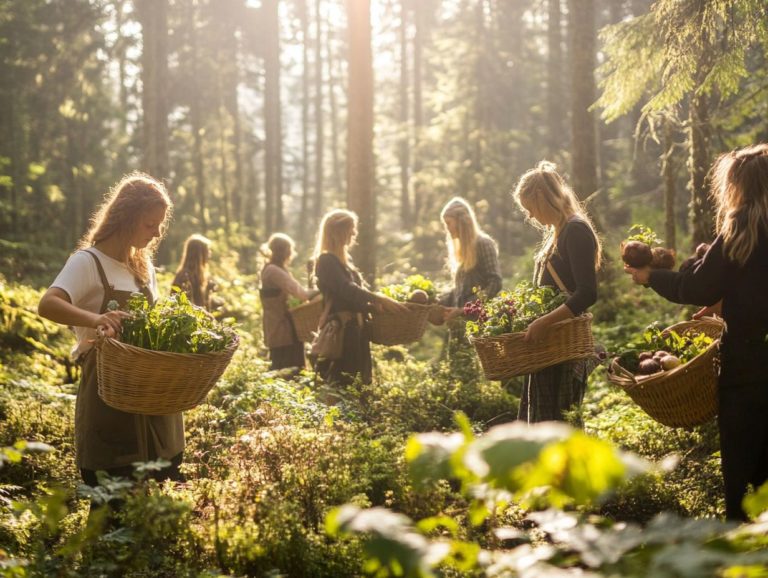How to Promote Foraging in Your Community
Foraging, the time-honored practice of gathering wild food, is making a remarkable comeback as you seek healthier, more sustainable lifestyles.
This article delves into the essence of foraging, emphasizing its environmental and health benefits. You’ll learn how to create a lively foraging community within your area through engaging events and educational initiatives.
Let s focus on safety first, so we ll provide guidelines on identifying edible plants and mastering proper harvesting techniques.
Explore the possibilities of collaborating with local organizations to foster a thriving, sustainable foraging community. Join us on this exciting journey into the world of foraging!
Contents
- Key Takeaways:
- Understanding Foraging
- The Benefits of Foraging
- How to Encourage Foraging in Your Community
- Foraging Safety Guidelines
- Building a Sustainable Foraging Community
- Frequently Asked Questions
- 1. What is foraging and why is it important to promote it in our community?
- 2. How can I start promoting foraging in my community?
- 3. Is foraging legal in my community?
- 4. How can foraging benefit my community?
- 5. Are there any safety considerations when it comes to promoting foraging in my community?
- 6. How can I get my community involved in foraging?
Key Takeaways:
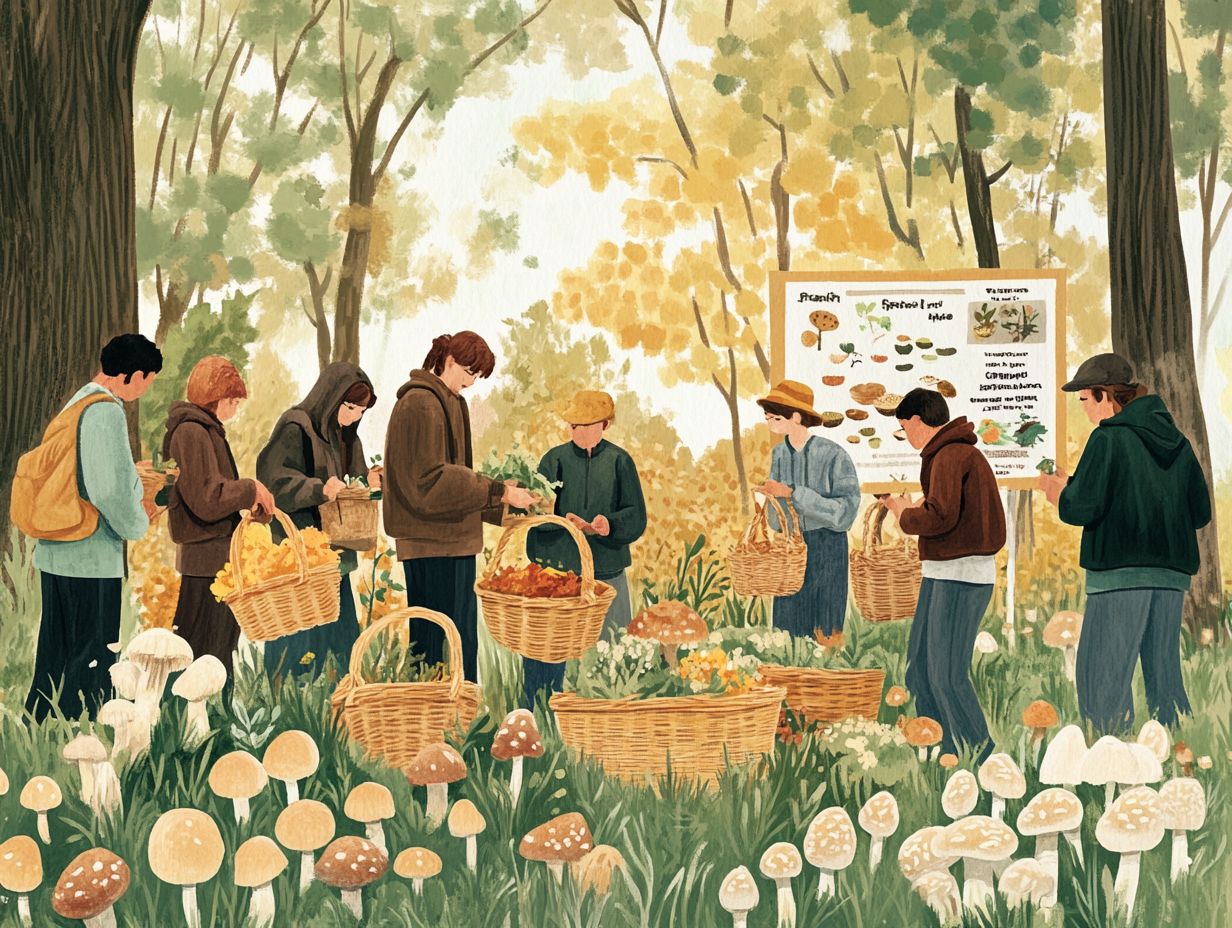
- Educate your community on the benefits of foraging for the environment and health.
- Create community foraging events and provide resources for identifying and safely harvesting edible plants.
- Foster a sustainable foraging community by collaborating with local organizations and sharing knowledge and resources.
Understanding Foraging
Understanding foraging is crucial for appreciating how your ancestors, the hunter-gatherers, thrived in diverse ecosystems by skillfully utilizing wild plants and local food sources.
Engaging in this practice helps you connect deeply with nature and underscores the importance of sustainable resource management in today s food systems.
As communities strive to reconnect with their ecological roots, foraging presents an opportunity for you to explore healthy plants that not only enhance health but also bolster food security. Additionally, learning how to share your foraging knowledge promotes cooperation among members of your community.
What is Foraging?
Foraging is the art of searching for and gathering wild food, focusing on identifying edible plants and mushrooms across diverse ecosystems.
This practice can take many forms; consider urban foraging, where you uncover hidden treasures in city parks and community gardens, or wildcrafting, which involves the responsible harvesting of plants from their natural habitats.
Grasping the nuances of these practices is essential, as they not only unveil unique flavors but also deepen your connection with the environment.
To forage successfully, you need to cultivate strong plant identification skills to avoid misidentifying harmful species. Engaging in educational opportunities, such as classes that teach you about using plants for health and workshops, offers invaluable insights into sustainable foraging methods, allowing you to respect local ecosystems while refining your skills.
The Benefits of Foraging
The benefits of foraging reach far beyond the mere act of gathering wild food; they encompass substantial environmental and health advantages that significantly enhance community well-being and sustainability.
By engaging in foraging practices, you can bolster food security, decrease reliance on conventional agriculture while simultaneously promoting biodiversity and ecological health.
This deeper connection to the landscape fosters stronger kinship ties and cooperative systems within your community, allowing for the sharing of knowledge and resources that elevate everyone involved.
Environmental and Health Benefits
Foraging offers a wealth of environmental and health benefits, enriching ecological systems by boosting biodiversity and granting access to healthy plants that enhance your overall well-being.
When you engage in foraging, you actively contribute to the maintenance of local ecosystems. This practice encourages the preservation of diverse plant species that are crucial for both wildlife habitats and human nutrition.
Gathering wild foods allows you to forge a deeper connection with nature while providing an exceptional opportunity to incorporate seasonal ingredients into your diet, thereby elevating your personal health.
By consuming these nutrient-dense foods, you can cultivate a more balanced diet, fostering community wellness as the shared knowledge of wild edibles nurtures a culture of sustainability. Integrating foraging into your daily life not only enriches your own experience but also promotes a healthier environment for all.
How to Encourage Foraging in Your Community
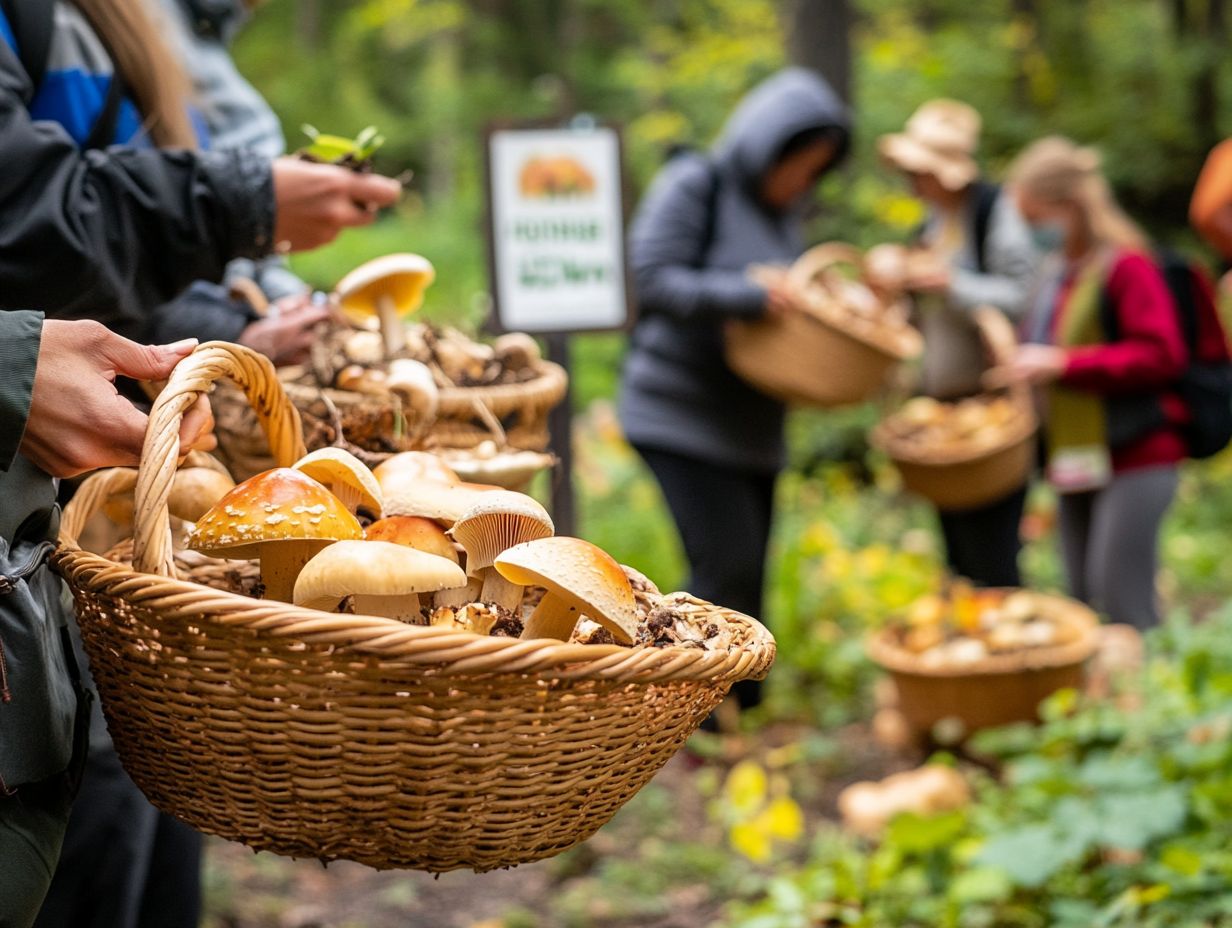
Encouraging foraging in your community can cultivate a dynamic culture focused on local food and shared knowledge. This approach not only fosters teamwork but also promotes ethical foraging in your community among residents.
By initiating community foraging events, you educate participants on plant identification and harvesting methods. This not only strengthens social norms that emphasize food sharing and sustainability but also creates a sense of belonging. For more guidance, consider these tips for starting your own foraging group.
This collective effort has the power to transform food deserts into thriving landscapes filled with local food sources, ultimately promoting control over local food sources and enhancing community health.
Creating Community Foraging Events
Organizing community foraging events is a fantastic way to bring people together and strengthen bonds, especially through seasonal foraging.
These events promote local food practices and encourage teamwork. They also offer a chance to connect with nature, explore native plants, and share knowledge about sustainable practices.
Local organizations must team up for an unforgettable experience, pooling their resources and expertise to enhance the event.
Consider organizing educational workshops, guided foraging walks, and interactive cooking demonstrations to make these events more engaging. Additionally, you could explore how to start a community garden with foraged edibles to encourage participants to share their foraging tips and recipes, cultivating a supportive atmosphere that deepens community ties.
To truly maximize the sharing potential, aim to create an inclusive environment where everyone feels welcome to participate and contribute their unique insights.
Education and Outreach
Education and outreach are essential in promoting foraging practices within your community, emphasizing plant identification, ethical foraging methods, and sustainability through foraging.
Incorporating a variety of educational strategies think hands-on workshops and interactive seminars provides practical experience while deepening understanding of local ecosystems.
Outreach programs enhance awareness and participation in local foraging initiatives. These programs create community events that highlight the benefits of sustainable practices and foster collaboration, ultimately inspiring a culture of appreciation for biodiversity and responsible foraging.
Foraging Safety Guidelines
Foraging safety guidelines are paramount to safeguarding your well-being as you venture into nature in search of edible plants. It’s crucial to accurately identify safe and nutritious wild foods while adhering to established outdoor safety protocols.
This dual focus not only enhances your foraging experience but also ensures that exploration remains both enjoyable and secure.
Identifying Safe and Edible Plants
Identifying safe and edible plants is an essential skill for you as a forager, vital for both your personal safety and the ecological balance of local ecosystems.
To refine this ability, tap into a variety of resources, such as field guides that meticulously outline the characteristics of local flora or online databases rich with images and descriptions of wild edibles.
Engaging in workshops led by seasoned foragers offers invaluable practical, hands-on learning experiences.
Commonly foraged plants like dandelions and purslane not only provide nutritional benefits but also support pollinators and enhance soil health. It’s vital to master safe identification techniques, such as scrutinizing leaf shapes and flower colors, to ensure you don t accidentally gather toxic lookalikes like wild hemlock.
Join us in your next community foraging event and discover the wonders of nature!
Proper Harvesting and Preparation Techniques
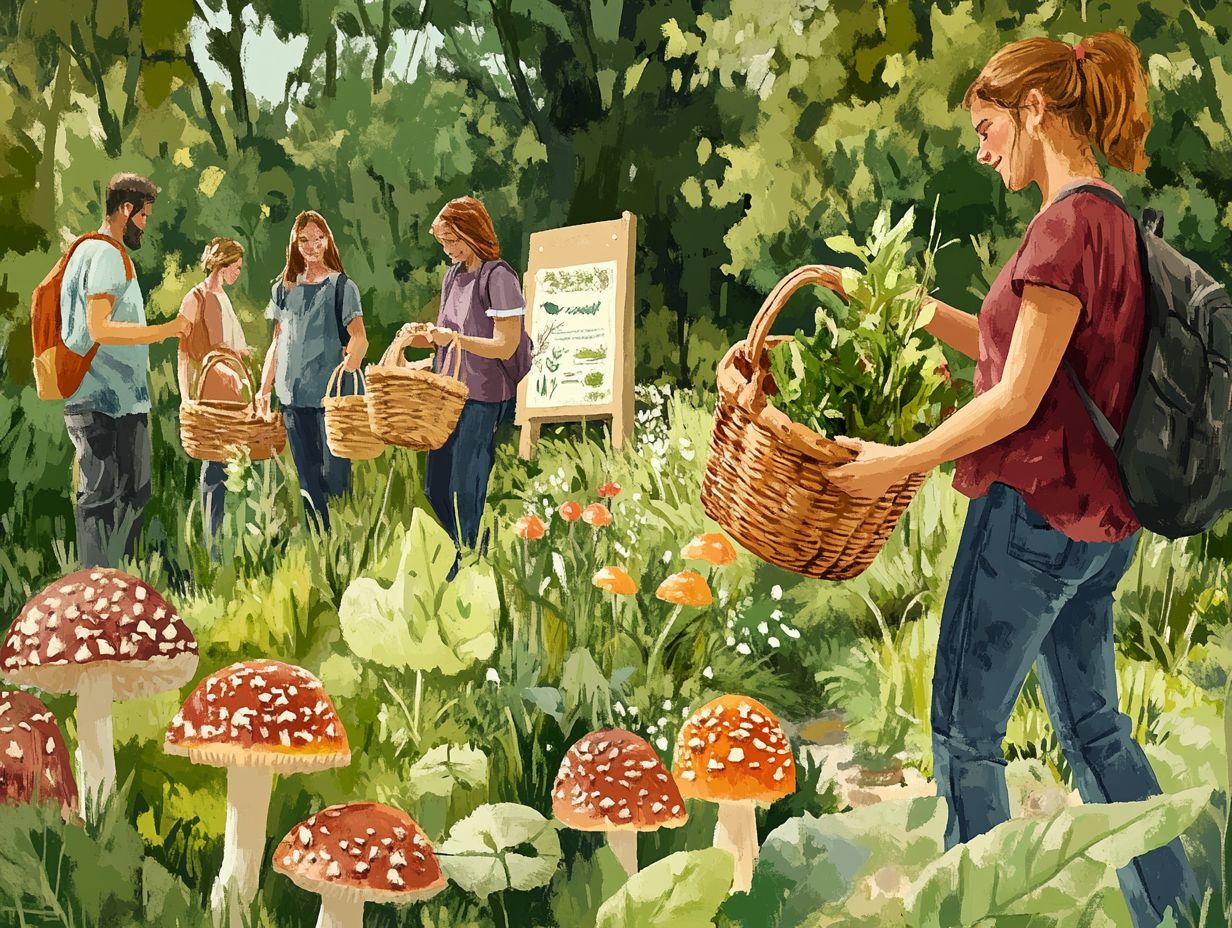
Proper harvesting and preparation techniques are essential for you as a forager. They ensure the sustainability of wild food sources while minimizing environmental impacts.
As you follow ethical guidelines, remember to collect only those plants that are abundant. Steer clear of rare species to protect local ecosystems. By utilizing sustainable methods like taking only what you need and leaving enough for wildlife you can help maintain balance in nature.
When it s time to prepare your wild edibles, consider blanching or steaming them. This will preserve their vibrant colors and essential nutrients, making sure they remain beneficial to your health.
It s also crucial for you to identify potential toxic look-alikes. Proper identification and safe cooking practices will guarantee a nutritious and secure dining experience.
Ultimately, embracing a respectful approach to wild food gathering allows you to foster a deep connection with nature while promoting its conservation.
Building a Sustainable Foraging Community
To cultivate a sustainable foraging community, you must prioritize collaboration among local organizations. By fostering an environment where resources and knowledge flow freely, you enhance not only food sovereignty but also the overall health of the community.
This shared effort lays the groundwork for a vibrant network that benefits everyone involved.
Collaborating with Local Organizations
Collaborating with local organizations can significantly enhance the impact of your sustainable foraging initiatives and community events. It offers a valuable platform for sharing knowledge and resources.
By joining forces with environmental groups and community gardens, you can cultivate a stronger sense of community spirit and environmental stewardship. These partnerships could lead to hands-on workshops where you and your participants learn about native edible plants and responsible harvesting techniques.
Organizing events centered around seasonal foraging can ignite interest in local biodiversity and conservation efforts. Ultimately, these collaborative endeavors create educational opportunities that enable individuals. This helps them forge a deeper connection with nature while promoting sustainable practices that benefit the entire community.
Sharing Resources and Knowledge
Sharing resources and knowledge within the foraging community is crucial for fostering cooperation and improving health.
By establishing dedicated platforms think community workshops, online forums, and local meet-ups you can exchange amazing insights about edible plants, their seasonal availability, and essential safety practices.
These initiatives not only create a sense of belonging but also promote collaboration among members. This deepens everyone’s understanding of the local ecosystem.
Such a network can significantly enhance food security by offering residents sustainable options to diversify their diets, ultimately enriching local food culture.
As you come together to share discoveries and experiences, you ll cultivate a vibrant community that celebrates and thrives on nature’s abundant gifts.
Frequently Asked Questions
1. What is foraging and why is it important to promote it in our community?
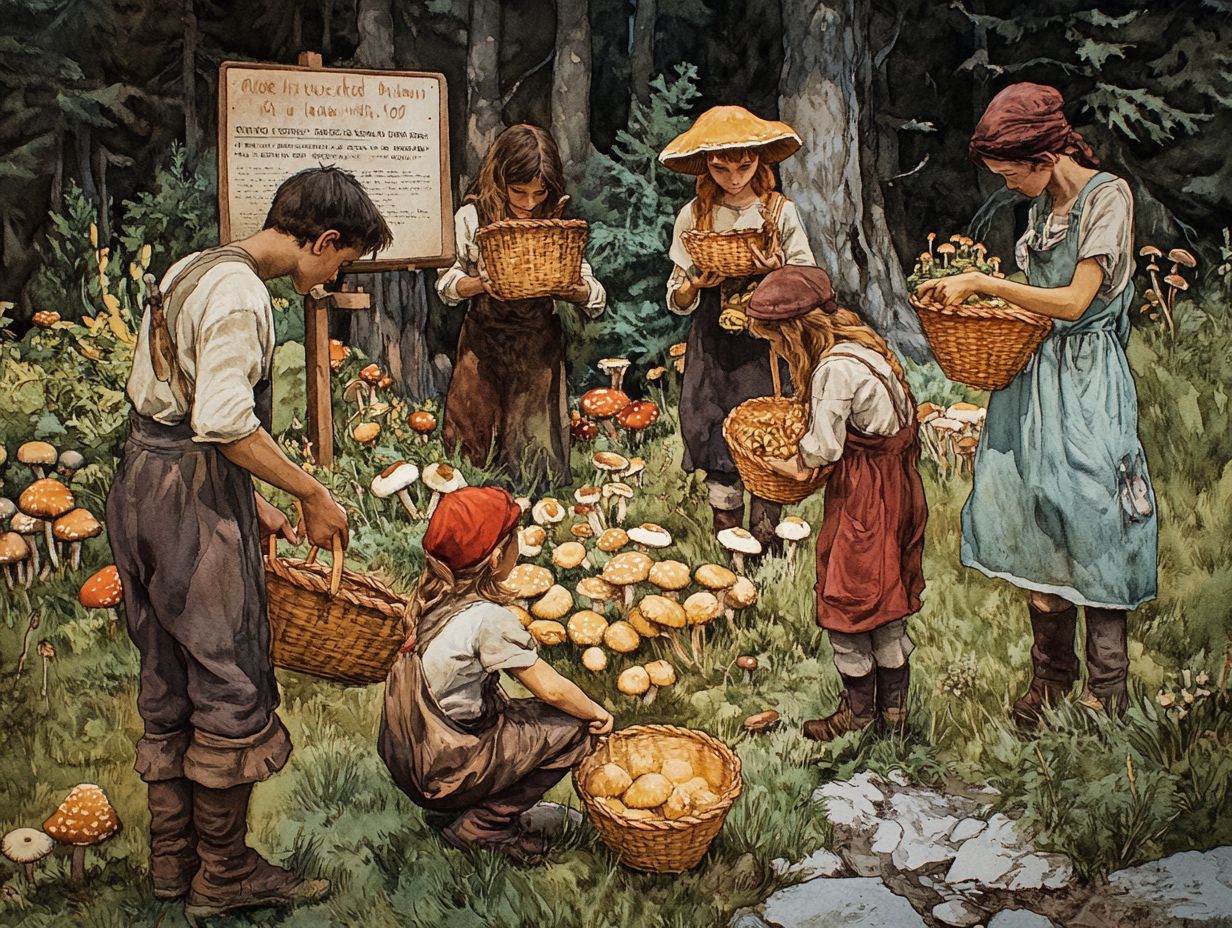
Foraging is the act of gathering wild edible plants, fruits, and other natural resources from the environment. It is important to promote foraging in our community because it supports sustainable and environmentally-friendly food practices, connects people with their local environment, and encourages self-sufficiency.
2. How can I start promoting foraging in my community?
There are several ways to promote foraging in your community. You can organize educational workshops or events, create foraging maps and guides for your local area, and set up foraging community events to collaborate with local organizations and businesses, raising awareness about the benefits of foraging.
3. Is foraging legal in my community?
Foraging, which is the act of gathering wild food resources, is legal in some areas but not in others. It is vital to research the foraging laws and regulations in your community before sharing information about it.
You might need to obtain permits or permissions from local authorities in some cases.
4. How can foraging benefit my community?
Foraging brings exciting benefits to your community! It provides access to nutritious and locally sourced food, reduces food waste, and fosters a sense of connection among people and with the environment.
5. Are there any safety considerations when it comes to promoting foraging in my community?
Yes, educating yourself and others about safe foraging practices is essential. This includes knowing how to identify edible plants and avoiding areas that might be contaminated.
Additionally, it’s crucial to respect private property and promote sustainable foraging by only taking what you need and leaving enough for others and wildlife.
6. How can I get my community involved in foraging?
You can engage your community by organizing group foraging trips and hosting educational events or workshops. Consider learning how to use foraging to educate others and start a community foraging group or club to bring people together!
Reach out to local schools, community centers, and organizations to introduce them to the benefits of foraging and encourage them to learn how to spread awareness on foraging techniques and incorporate it into their activities.
Join us in creating a vibrant foraging community today!
